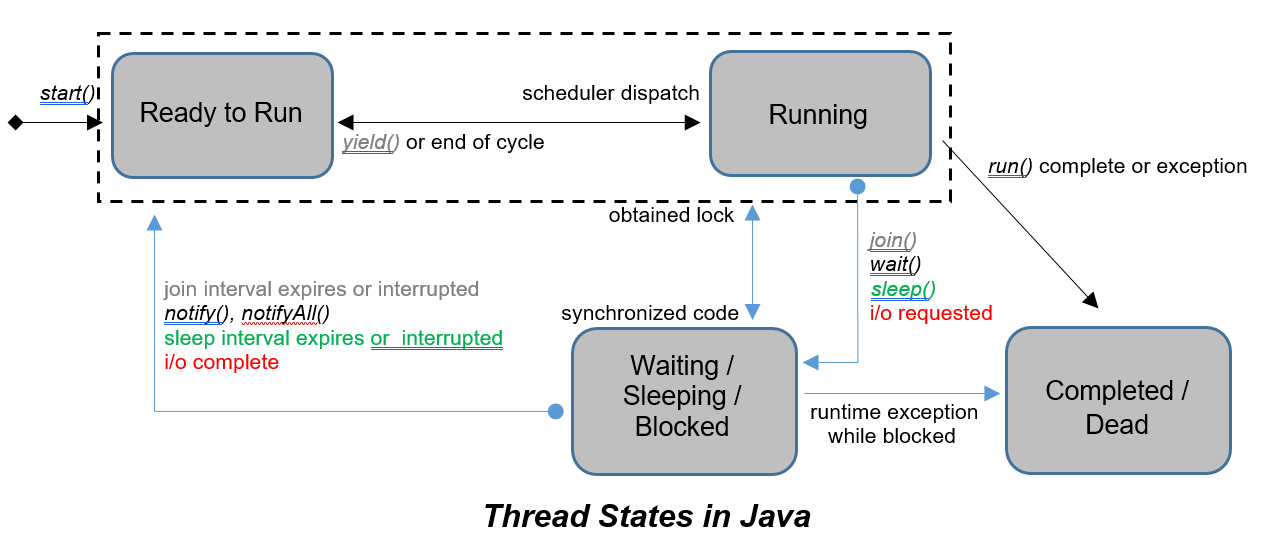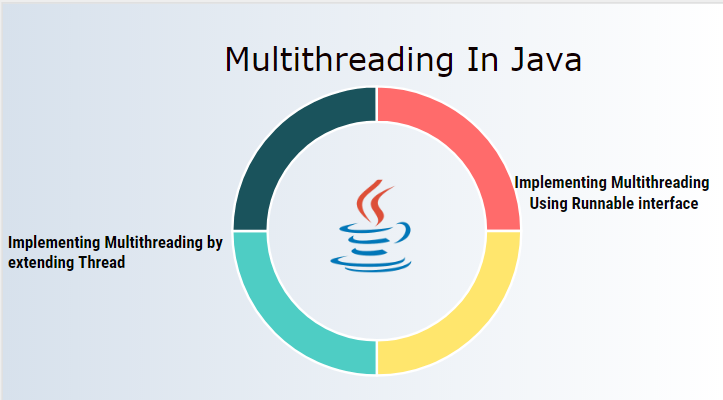Explain Different Ways of Implementation of Multithreading in Java
If you choose to implement Runnable you can extend class then. Myclass t new myclass.

Java Multithreading Explained Developer Com
Java provides a way of creating threads and synchronizing their tasks using synchronized blocks.

. Everything else that creates threads in Java code falls back to this one way behind the cover eg. Synchronized blocks in Java are marked with the synchronized keyword. 37 rows Multithreading in Java is a process of executing multiple threads simultaneously.
Mutual Exclusive helps keep threads from interfering with one another while sharing data. Before we begin with the programscode of creating threads lets have a look at these methods of Thread class. SystemoutprintlnThis code is outside of the thread.
Concept of Lock in Java. So threads are light-weight processes within a process. Public void sleep long miliseconds.
Is used to perform action for a thread. To become efficient in writing the multithreaded code you must know about the constructors and the methods of thread class before starting to write multithreading programs in Java. A ThreadFactory implementation will instantiate Thread objects at some point.
Your thread creates unique object and associate with it. These are the two different ways to create thread in java. Another thing to note since you can extend only one class in Java if you extends Thread you cant extend another class.
The easiest way to create a thread is to create a. Creating a thread in Java. Public void run int a 10.
In this tutorial we saw multithreaded applications in Java and how to use single and multi thread in Java. By using new perator like Thread t1 new. By Using Synchronized Method.
Systemoutprintln Thread started running. Cooperation Inter-thread communication in java Mutual Exclusive. Extending the Thread class.
The second thing is to call the start method on Thread class object to create a thread of execution in Java Stack area. Java offers implementation of multi-threading by two ways. A class can implement multiple interfaces in which all the methods of interfaces must be overridden.
In these two ways first step we need to override run method and place corresponding logic that should be executed concurrently. Consider an example Suppose we have two different threads T1 and T2 T1 starts execution and save certain values in a file temporarytxt which will be used to calculate some result when T1 returns. Java accomplishes multithreading through its javalangThread class.
To implement multithreading Java defines two ways by which a thread can be created. User thread is created when the application first starts. Systemoutprintln Thread started running.
This class overrides the run. There is exactly one way to create a new thread in Java and that is to instantiate javalangThread to actually run that thread you also need to call start. Implementing the Runnable Interface.
Starts the execution of the threadJVM calls the run method on the thread. In other words the thread is dead and there is no way one can respawn active after kill the dead thread. We have used few of these methods in the example below.
Java is a multi-threaded programming language which means we can develop multi-threaded program using Java. In multithreading users are not blocked as threads are independent and can perform multiple operations at time. Create thread in java using Runnable.
By implementing the Runnable interface. Java threads are of two types. The feature of multiple inheritance in java is eliminated.
You should extend Thread class only when you need to override use or modify some of the code of Thread class. It can be achieved by using the following three ways. A synchronized block in Java is synchronized on some object.
By Implementing Runnable interface. There are mainly two way to do multithreading. And do this only when you are sure that your class wont need to extend other class.
By Using Static Synchronization. In Java one can get the current state of a thread using the ThreadgetState method. Implementing the Runnable Interface.
1 Using Thread class. Public void run SystemoutprintlnThis code is. The following diagram shows the different states involved in the life cycle of a thread.
There are two ways to create a thread in Java. Each part of such program is called a thread. 2 By implementing Runnable interface.
By Using Synchronized Block. 1 By extending Thread class. Public class Main implements Runnable public static void mainString args Main obj new Main.
Run method to perform action for thread. A multi-threaded program contains two or more parts that can run concurrently and each part can handle a different task at the same time making optimal use of the available resources specially when your computer has. All synchronized blocks synchronize on the same object can only have one thread executing inside them at a time.
Meanwhile T2 starts and before T1 returns T2 change the values saved by T1 in the file temporarytxt temporarytxt is the shared resource. Explain multithreading in Java. To inherit a class is to be extended by another class to reuse the class elements and extend itself.
Various stages of life cycle of the thread are New. Class myclass extends Thread. By extending the Thread class.
Thread creation by extending the Thread class We create a class that extends the javalangThread class. There are two ways creating of a thread by Implementing Runnable interfaceExtending Thread classwhen using runnable interface its have facility to extends another classes so we can acheive multiple inheritanceby using Thred class we have so many methods like notify resume suspend notifyall wait methods. By extending Thread class.
Implementing runnable interface by extending Thread class public class ThreadExample1 extends Thread run method to perform action for thread. Implementation of Thread States. Public void start.
In this you have to just extend the Thread classAfter extending simply make the object of your class. Java Thread Class methods usage and examples. Causes the currently executing thread to sleep temporarily cease execution for the.
Threads can be created by using two mechanisms. Where as in inheritance concept all the methods if needed can be invoked directly and need not be overridden. Then we can create as many user and daemon thread.
Daemon threads are mainly used in the background and are used for tasks like cleaning the application etc. Public void run. There are two different ways.
Thread thread new Threadobj. Int result ab. It shares the same object to multiple threads.

Threads In Java Creating Threads And Multithreading In Java

What Is Multithreading In Java Implementation Uses Career Growth
No comments for "Explain Different Ways of Implementation of Multithreading in Java"
Post a Comment